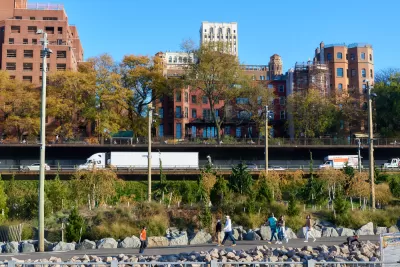Supporters of the waterfront park worry NYCDOT’s plan to potentially widen the Brooklyn-Queens Expressway could reduce green space in “one of the most expensive urban parks ever built.”

If the New York City Department of Transportation goes ahead with a proposal to expand the Brooklyn-Queens Expressway, known locally as the BQE, to three lanes in each direction, the road could cut into green space now part of the Brooklyn Bridge Park, reports Kevin Duggan for Streetsblog NYC.
The park, an 85-acre space completed between 2010 and 2021, is “one of the most expensive urban parks ever built” at $400 million. Former Traffic Commissioner San Schwartz and former Transportation Commissioner Hank Gutman both made public comments signaling their concern for the park and how an expanded highway footprint would damage the green space created by it.
DOT’s plans aren’t entirely clear, Duggan writes. While “DOT’s conceptual renderings of a future highway do indeed show substantial new open spaces covering the roadways and sloping down to Brooklyn Bridge Park,” the renderings show a 40-foot-wide highway, which would only accommodate two lanes in each direction. Yet in a December statement, DOT said the agency anticipates that their analysis “will result in three lanes of traffic.”
An analysis conducted by Schwartz’s firm three years ago “found the roadway could work with just two lanes if officials tried to discourage driving by closing some ramps or limiting them to high-occupancy vehicles, or by charging to cross the East River bridges at the same rates as the tolled Hugh Carey Tunnel.” A spokesperson for the park says “park officials had been assured the repairs would not reduce green space.”
FULL STORY: Wider BQE Could Be ‘Intrusion’ on Brooklyn Bridge Park, Ex-Transportation Leaders Warn

Study: Maui’s Plan to Convert Vacation Rentals to Long-Term Housing Could Cause Nearly $1 Billion Economic Loss
The plan would reduce visitor accommodation by 25,% resulting in 1,900 jobs lost.

North Texas Transit Leaders Tout Benefits of TOD for Growing Region
At a summit focused on transit-oriented development, policymakers discussed how North Texas’ expanded light rail system can serve as a tool for economic growth.

Using Old Oil and Gas Wells for Green Energy Storage
Penn State researchers have found that repurposing abandoned oil and gas wells for geothermal-assisted compressed-air energy storage can boost efficiency, reduce environmental risks, and support clean energy and job transitions.

Private Donations Propel Early Restoration of Palisades Playground
Los Angeles has secured over $1.3 million in private funding to restore the Pacific Palisades playground months ahead of schedule, creating a modern, accessible space that supports community healing after recent wildfires.

From Blight to Benefit: Early Results From California’s Equitable Cleanup Program
The Equitable Community Revitalization Grant (ECRG) program is reshaping brownfield redevelopment by prioritizing projects in low-income and environmental justice communities, emphasizing equity, transparency, and community benefits.

Planting Relief: Tackling Las Vegas Heat One Tree at a Time
Nevada Plants, a Las Vegas-based nonprofit, is combating the city’s extreme urban heat by giving away trees to residents in underserved neighborhoods, promoting shade, sustainability, and community health.
Urban Design for Planners 1: Software Tools
This six-course series explores essential urban design concepts using open source software and equips planners with the tools they need to participate fully in the urban design process.
Planning for Universal Design
Learn the tools for implementing Universal Design in planning regulations.
Ascent Environmental
Borough of Carlisle
Institute for Housing and Urban Development Studies (IHS)
City of Grandview
Harvard GSD Executive Education
Toledo-Lucas County Plan Commissions
Salt Lake City
NYU Wagner Graduate School of Public Service





























